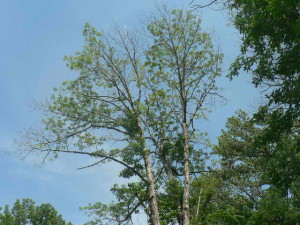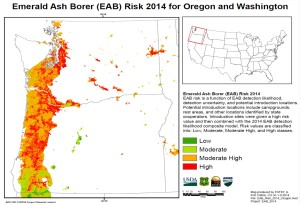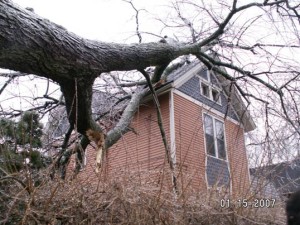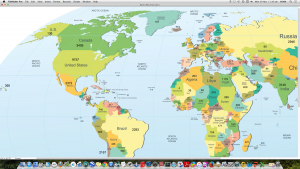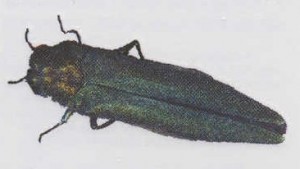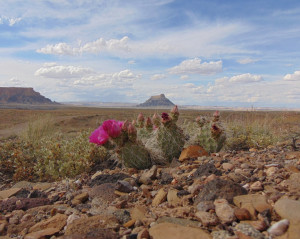If you have read my earlier work, you know that I think the international phytosanitary “system” is not working well to prevent introduction of novel arthropods and pathogens that attack naïve plant hosts in the new ecosystem. For example, see my blog in May on the study of introduced forest pests with Gary Lovett as senior author; my blog in April 2016 on Phytopththoras in Europe; discussions of the problems in my reports, Fading Forests II and Fading Forests III – available here.
One plant breeder has read the critiques by Clive Brasier (world-famous British forest pathologist) and others and apparently concluded that the solution is not to strengthen phytosanitary measures but to abandon them! He suggests that instead of attempting to prevent pest introductions, agriculture should instead rely on new breeding technologies to rapidly breed plants that are resistant to the introduced pest.
D. Zamir (who works at the Institute of Plant Sciences and Genetics, Faculty of Agriculture, The Hebrew University of Jerusalem) has published an article in Plos 1 Biology citing Brasier’s criticisms (see Dr. Brasier’s web link above and my Phytophthora blog). Zamir calls for the International Plant Protection Convention (IPPC) to launch a global plant breeding project. In his view, such a project would not only improve plant species’ resilience vis a vis pest attacks. It would also build the scientific capacity of countries with high biological diversity
Zamir says that the IPPC is waging a losing defensive strategy that imposes ever-more regulations on plant movement and exposes those who would like to move plants for various reasons to increasingly heavy penalties if they violate the rules. At the same time, the internet provides unlimited opportunities for anyone to obtain mail-ordered seed, often with free international shipping.
Citing Brasier, Zamir notes that the current phytosanitary system has the following flaws:
- The system ignores the approximately 90% of pathogens that are unknown to science.
- It assumes that potential hosts will be taxonomically related to those affected in the country of origin, whereas the host range may be much wider in the new environment.
- Reliance on visual evaluations fails because pathogens might be present in a form that does not cause symptoms (e.g., spores).
- Aggressive pathogens identified in a particular country might not be recognized as a risky pest by the international community because of inefficient global communication of such threats.
Zamir says that biological diversity drives improvements in crop productivity and resilience to diseases and environmental stresses. In his view, release of new varieties provides added value to consumers, producers, and the environment. Breeding programs often rely on the use of wild species and local varieties for gene mapping and rapid deployment of traits. However, Zamir complains, the international system hampers exchanges of seed among countries. It is often not possible to ascertain if the original seed used as a source of the traits was obtained in accordance with all the phytosanitary regulations. Zamir says that breeders often “cut through the red tape” by sending the seed through the mail without obtaining a phytosanitary certificate.
Zamir then proposes that people concerned about plant productivity and health in the face of growing trade volumes and vulnerability to insects and pathogens should abandon reliance measures intended to prevent introductions of pests and instead launch a massive plant breeding program.
While his focus is apparently on crop breeding, Zamir cites success in breeding elm trees resistant to the Dutch elm disease pathogens as proof that this approach can work – and that success depends on access to the full genetic variability of the target species.
Zamir concedes that he has not addressed issues of governance, financing, selection of the species to be included in the program, and how to involve the private sector.
Of course, movement of seeds across ecological barriers poses less of a risk of introducing an alien pest than does movement of whole plants or cuttings. For that reason, phytosanitary regulations governing seed movement are more lenient than those for plants and cuttings.
I consider Zamir to wildly underestimate the difficulty – nay, impossibility – of applying his approach. To date, efforts to breed trees resistant to individual pests have required decades of effort. The U.S. tree breeding system falls far short of what is needed to respond to pests already in the country (see Chapter 6 of Fading Forests III, available here). For example, American chestnut has benefitted from decades of devoted effort – but success in countering chestnut blight is not yet certain, and the tree is under attack by another half-dozen pests. (To see a reminder of how many tree taxa are under threat from non-native pests, go to the write-ups on the Don’t Move Firewood website or re-read articles by Lovett et al. or Aukema et al. 2010 — citations provided below.)
Even though modern genetic techniques, e.g., CRISPR –Cas9, seem to promise faster and cheaper breeding methods, how would breeding programs catch up to the tidal wave of new introductions?
Furthermore, few breeding programs for North American forest trees have yet proved a capacity to restore trees to the forest.
Finally, Zamir’s proposal would compound the existing equity problem. Already, the cost, environmental degradation, and other burdens of countering pest spread lie predominantly on the receiving society – including municipal tax payers and homeowners who must remove and replace trees killed by introduced pests (see Aukema et al. 2011.) Those who profit from international trade rarely pay directly. Zamir’s proposal would exacerbate that inequity by transferring all the risk of new introductions and cost of responding to new pests to the receiving ecosystem and the broad public. Those profiting from the trade would face next to no responsibility.
Fortunately, most plant breeders engaged in moving seed internationally have taken a more productive approach to adapting the international phytosanitary system to accommodate their business. The North American countries adopted a regional standard on the seed trade (RSPM# 36) in 2012. A draft global standard will soon be circulated for comments by the IPPC member countries.
As I have said before, I call on phytosanitary agencies and the multitude of stakeholders harmed by pest movement – including grant-making foundations; federal and state agencies; conservation non-governmental organizations; forest products companies; trade associations representing various aspects of international trade in plants, wood packaging, and other vectors; and urban tree programs and mayors – to work together to improve U.S. and international phytosanitary programs.
SOURCES
Aukema, J.E., B. Leung, K. Kovacs, C. Chivers, K. O. Britton, J. Englin, S.J. Frankel, R. G. Haight, T. P. Holmes, A. Liebhold, D.G. McCullough, B. Von Holle.. 2011. Economic Impacts of Non-Native Forest Insects in the Continental United States PLoS One September 2011 (Volume 6 Issue 9)
Aukema, J.E., D.G. McCullough, B. Von Holle, A.M. Liebhold, K. Britton, & S.J. Frankel. 2010. Historical Accumulation of Nonindigenous Forest Pests in the Continental United States. Bioscience. December 2010 / Vol. 60 No. 11
Campbell, F.T. and S.E. Schlarbaum. Fading Forests I, II, and III at http://treeimprovement.utk.edu/FadingForests.htm
Lovett, G.M., M. Weiss, A.M. Liebhold, T.P. Holmes, B. Leung, K.F. Lambert, D.A. Orwig , F.T. Campbell , J. Rosenthal, D.G. McCullough, R. Wildova, M.P. Ayres, C.D. Canham, D.R. Foster, S.L. LaDeau, and T. Weldy. 2016. Nonnative forest insects and pathogens in the United States: Impacts and policy options. Ecological Applications, 0(0), 2016, pp. 1–19. DOI 10.1890/15-1176.1 Available at www.caryinstitute.org/tree-smart-trade
Zamir D (2016) Farewell to the Lose–Lose Reality of Policing Plant Imports. PLoS Biol 14(4): e1002438. doi:10.1371/journal.pbio.1002438 Published: April 19, 2016Available at http://journals.plos.org/plosbiology/article?id=10.1371/journal.pbio.1002438 Or http://www.ncbi.nlm.nih.gov/pubmed/27093460
Posted by Faith Campbell

